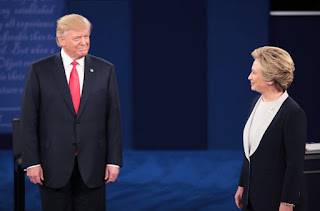 |
| Donald Trump with Larry Holmes, Don King, and Mike Tyson Getty Images gettyimages.com |
It is Wednesday which means it is time for the weekly edition of Blogger Candidate Forum. Blogger's fingers got a well deserved rest after the fast, furious, nasty debates. One of the points Republican nominee Donald Trump kept repeating was how inner city African American and Latino communities are synonymous with "inner city" crime. This thinking has made its way into public policy and popular culture. Equating "inner city" crime with African American communities is not something new. This equation has been around since, at least, the forties. Brentin Mock, in his CityLab article "Donald Trump's Blaxploitation of 'Inner Cities,'" writes, "That may have been true of the Harlem of the 1940s and 1950s, during the era of Bumpy Johnson, or the Harlem of the 1960s and 1970s, under Frank Lucas and Nicky Barnes. It could even describes the Harlem of the 1980s and 1990s..." However, this is not what Harlem is like today.
 |
| Luke Cage planet-aviation.com |
 |
| A scene from Luke Cage collider.com |
This cat named Moynihan went and hollered at Nixon...and the prez that maybe the inner city could benefit from benign neglect.
Mr. Mock observes, "It's an interesting line, except Moynihan's 'benign neglect' they was not about 'inner cities.' The reference is from a meme Moynihan wrote to President Richard Nixon on January 16, 1970 about prevailing economic and social 'Negro' conditions." He proceeds to quote the late Daniel Moynihan's exact words on 'benign neglect" theory:
The time may have come when the issue of race could benefit from a period of 'benign neglect.' The subject has too much talked about. The forum has been too much taken over to hysterics, paranoids, and boodles on all sides. We may need a period in which Negro progress continues and racial rhetoric fades.
 |
| The late Daniel Moynihan en.wikipedia.org |
The inner city is the place that burned when King was assassinated. It was Watts. It was the place Ronald Reagan had to try to conduct the war on drugs. (http://www.nytimes.com; date accessed Oct. 26, 2016)
President Nixon eventually invested little in the 'benign neglect" theory, choosing to amplifying the racial rhetoric, assigning the rising crime rates and drug usage to uniquely "Negroid features of major U.S. cities." President Nixon made use of this character definition to justify his position "...that these 'inner cities' needed brought to heel through aggressive 'law and order' tactics."
This was the very same position Donald Trump took during that infamous October 9 debate, declaring that "'inner cities' across the U.S. are 'a disaster education-wise, job-wise, safety-wise in every way possible." Ms. Badger pointed out that this was the furtherest thing from the truth. (Ibid)
 |
| A moment from the second Presidential Debate denverpost.com |
Any other uptown native might've been quicker to discover that Harlem's greater, untouchable menace is the NYPD. But what, Luke Cage wonders, about black-on-black crime? (http://www.theringer.com; date accessed Oct. 26, 2016)
Donald Trump has pondered this question as well. In the meantime, the New York Police Department is anxious by Mr. Trump's mis-representations of crime, specifically in New York City, head Trumpeter Rudy Giuliani was mayor. The truth is crime, violent crime in particular, are at their lowest rates in decades-despite not because of Mr. Guilani's heavy-handed tactics. This is a fact not only in Harlem, but throughout New York City and almost every major city in the United States. Mr. Mock points out, "This explains why so many law enforcement leaders are at odds with Trump's anti-crime proposals, including his ill-considered call for expanding stop-and-frisk."
 |
| Crime statistics for NYPD's 28th Precinct which includes Central Harlem New York Police Department citylab.com |
During his "inner city" tirades, Mr. Trump purposefully, like many "black-culture-birther urban crime theorists," is how facilitating white flight did more than anything to transform urban core into destitute ghettoes. This is hardly the benign neglect that Daniel Moynihan was referring to-it was purposeful.
In 1980, the late writer James Baldwin was asked by Wolfgang Binder about the state of African American ghettos in American cities. Mr. Baldwin responded,
It is a ghetto and white people turn them into ghettos to get away from the niggers. It's a vicious circle. They move out, the entire economic basis of the city crumbles, because nothing is taken care of in Harlem. The City has no responsibility for the ghetto, the cops don't live in the ghetto, tax-payers don't live in the ghetto, so nothing comes in. What little was coming in is lost. Nothing is owned by black people in Harlem, or a fraction of what is owned in Harlem is owned by black people. It is owned by by banks, by real estate, by vast organizations including the Catholic Church, including universities. So houses are boarded up, and presently what will happen, what is happening in other cities is that bulldozers move in, move the niggers out, somewhere else, and the land is claimed by white people.
This is the true story of American 'inner-cities" or at least, for most of the 20th century onward. However, misinterpretations of what Daniel Moynihan and the "tough on crime" magpies have infected both policy and popular culture. We are not talking about the images of Stevie Wonder songs, they are the machinations of people who see African Americans in a criminal context. Life is never perfect in any city-and certainly not idyllic for many urban African American communities across the United States. Why are African American lives not improving in these areas? It might just be because the debates are avoiding the real culprits.
No Matter who will at this election! But Donald Trump will always as a Joker.
ReplyDelete